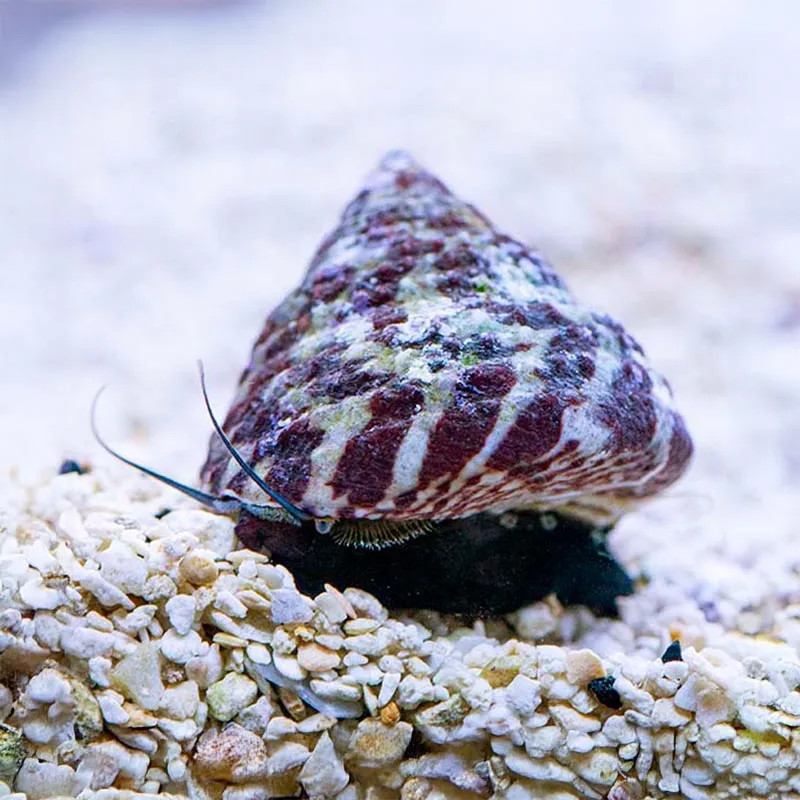Stocks Available
Nassarius Snail - (Mexico)
SKU:207457
NASSARIUS SP.
0.25-0.5 INCH

Stock Available
Introduction: • Species: Banded Trochus • Common Names: Banded Trochus Snail, Top Snail • Natural Habitat: Found in the shallow reefs and rocky shorelines of the Indo-Pacific region, especially in areas with abundant algae. Physical Characteristics: • Appearance: These snails have a distinctive conical shell, usually adorned with alternating bands of light and dark colors, such as brown, white, and gray. The shell has a smooth, glossy surface with a sharp spiral point at the top. • Size: Typically grows up to 2 inches (5 cm) in diameter. • Lifespan: They can live up to 5 years in captivity under optimal conditions. Habitat Requirements: • Tank Size: Minimum of 10 gallons, though larger tanks are recommended for multiple snails. • Water Conditions: o Temperature: 72-78°F (22-26°C). o pH: 8.1-8.4. o Salinity: 1.023-1.025 specific gravity. • Aquascaping: Requires plenty of live rock surfaces covered with algae for grazing. They may also burrow into sand and rubble areas when at rest. Diet: • Primary Diet: Herbivorous; primarily consumes algae, including diatoms and film algae found on rock surfaces and tank walls. • Supplemental Feeding: If natural algae levels are low, provide dried seaweed (nori) or algae wafers. • Feeding Frequency: Continually grazes throughout the day, so supplemental food should be available if algae is scarce. Compatibility: • Temperament: Peaceful and non-aggressive. • Suitable Tank Mates: Safe with all reef inhabitants, including fish, corals, and other invertebrates. Ideal for peaceful community tanks. • Incompatibilities: Should not be housed with aggressive or predatory species like triggerfish or large crabs that may harm the snail. Care Level: • Difficulty: Easy to moderate; requires a stable, mature aquarium with an adequate supply of algae. • Health Monitoring: Watch for shell erosion or damage due to poor water quality, as well as insufficient food sources leading to starvation. Breeding: • Breeding in Captivity: Breeding has been observed in home aquariums, but it is rare. They reproduce by external fertilization, releasing eggs and sperm into the water column. • Spawning: Eggs hatch into free-swimming larvae, which eventually settle and develop into snails. Economic Considerations: • Market Demand: High demand in reef aquariums for their algae-grazing abilities. • Pricing: Generally affordable and commonly available in the trade. Sustainability and Conservation: • Wild Population: Generally stable, though overcollection for the aquarium trade in some regions can be a concern. • Aquaculture Efforts: Captive breeding programs are increasingly popular to reduce pressure on wild populations. • Conservation: Ensure that snails are sourced from ethical suppliers, supporting sustainable practices. Conclusion: The Banded Trochus Snail is a highly valuable addition to marine aquariums, especially for its effective algae control. Its peaceful temperament and easy care make it an ideal choice for both beginners and experienced aquarists. With proper conditions, this snail can thrive, contributing to the overall health and cleanliness of the tank.
Data sheet
5 other products in the same category:
Customers who bought this product also bought: